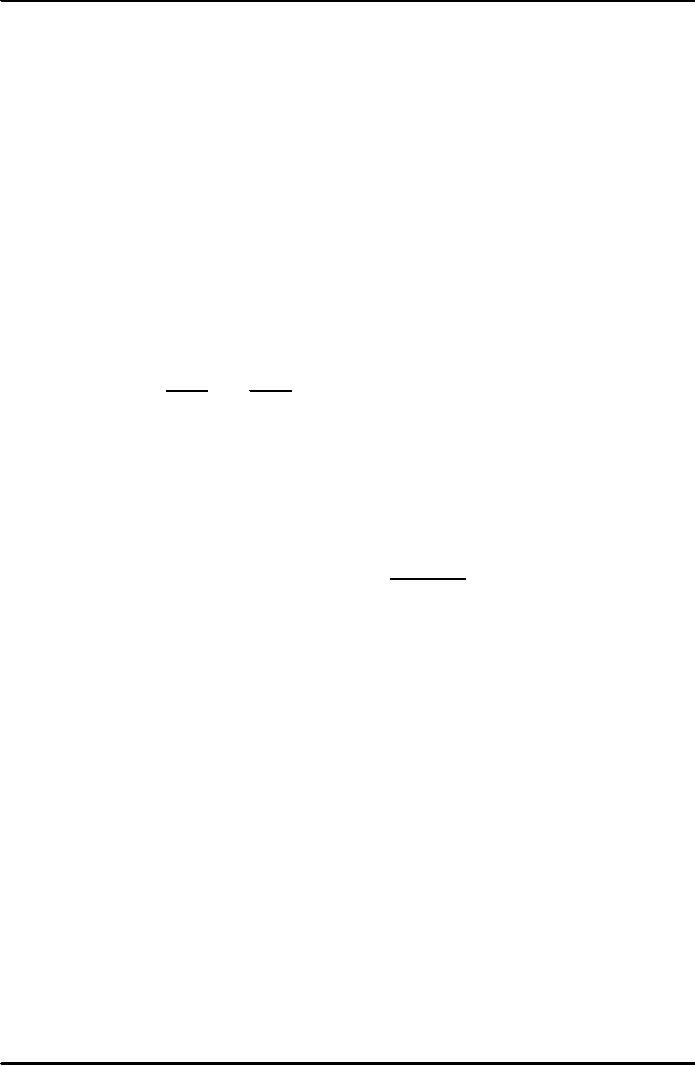 |

Macroeconomics
ECO 403
VU
LESSON
23
ECONOMIC
GROWTH (Continued...)
2.
Policies to increase the
saving rate
�
Reduce
the government budget
deficit
(or
increase the budget
surplus)
�
Increase
incentives for private
saving:
�
Reduce
capital gains tax, corporate
income tax, estate tax as
they discourage
saving
�
Replace
federal income tax with a
consumption tax
�
Expand
tax incentives for
individual retirement accounts
and other retirement
savings
accounts
3.
Allocating the economy's
investment
�
In
the Solow model, there's
one type of capital.
�
In
the real world, there
are many types,
which
we can divide into three
categories:
Private
capital stock
Public
infrastructure
Human
capital:
the
knowledge and skills that
workers acquire through
education
�
How
should we allocate investment
among these types?
Two
viewpoints
1.
Equalize tax treatment of
all types of capital in all
industries, and then let
the market
allocate
investment to the type with
the highest marginal
product.
2.
Industrial
policy: Govt.
should actively encourage
investment in capital of certain
types
or
in certain industries, because
they may have positive
externalities (by-products)
that
private
investors don't
consider.
Possible
problems with industrial
policy
�
Does
the govt. have the
ability to "pick winners"
(choose industries with the
highest return to
capital
or biggest externalities)?
�
Would
politics rather than
economics influence which
industries get preferential
treatment?
4.
Encouraging technological
progress
�
Patent
laws:
encourage
innovation by granting temporary
monopolies to inventors of new
products
�
Tax
incentives for R&D
�
Grants
to fund basic research at
universities
�
Industrial
policy:
encourage
specific industries that are
key for rapid tech.
progress
(subject
to the concerns on the
preceding slide)
92

Macroeconomics
ECO 403
VU
Growth
empirics: Confronting the
Solow model with the
facts
Solow
model's steady state
exhibits balanced growth -
many variables grow at the
same rate.
�
Solow
model predicts Y/L
and
K/L
grow
at same rate (g),
so that K/Y
should
be
constant.
This is true in the real
world.
�
Solow
model predicts real wage
grows at same rate as
Y/L,
while real rental price
is
constant.
Also true in the real
world.
Convergence
�
Solow
model predicts that, other
things equal, "poor"
countries (with lower Y/L
and K/L )
should
grow faster than "rich"
ones.
�
If
true, then the income
gap between rich & poor
countries would shrink over
time, and
living
standards "converge."
�
In
real world, many poor
countries do NOT grow faster
than rich ones. Does
this mean the
Solow
model fails?
�
No, because
"other things" aren't
equal.
In
samples of countries with
similar savings & population
growth rates,
income
gaps shrink about
2%/year.
In
larger samples, if one
controls for differences in
saving, population growth,
and
human
capital, incomes converge by
about 2%/year.
�
What
the Solow model really
predicts is conditional convergence -
countries converge to
their
own steady states, which
are determined by saving,
population growth, and
education.
And
this prediction comes true
in the real world.
Factor
accumulation vs. Production
efficiency
Two
reasons why income per
capita are lower in some
countries than
others:
1.
Differences in capital (physical or
human) per worker
2.
Differences in the efficiency of
production (the height of
the production
function)
Studies:
�
Both
factors are important
�
Countries
with higher capital (phys or
human) per worker also
tend to have higher
production
efficiency
Explanations:
�
Production
efficiency encourages capital
accumulation
�
Capital
accumulation has externalities
that raise efficiency
�
A
third, unknown variable
causes cap accumulation and
efficiency to be higher in
some
countries
than others
Endogenous
Growth Theory
�
Solow
model:
Sustained
growth in living standards is
due to tech progress
The rate
of tech progress is
exogenous
93

Macroeconomics
ECO 403
VU
�
Endogenous
growth theory:
a set of
models in which the growth
rate of productivity and
living standards is
endogenous
A
basic model
�
Production
function: Y = A K
where
A is the amount of output
for each unit of capital (A
is exogenous & constant)
�
Key
difference between this
model & Solow: MPK is constant
here, diminishes in
Solow
�
Investment:
s Y
�
Depreciation:
δ
K
�
Equation
of motion for total
capital:
ĆK
= s Y -
δ K
�
Divide
through by K
and
use Y
=
A
K ,
get:
ΔY
ΔK
=
sA
- δ
=
Y
K
�
If
s A >δ,
then income will grow
forever, and investment is
the "engine of growth."
�
Here,
the permanent growth rate
depends on s.
In Solow model, it does
not.
Does
capital have diminishing
returns or not?
�
Yes,
if "capital" is narrowly defined
(plant & equipment).
�
Perhaps
not, with a broad definition
of "capital" (physical & human
capital, knowledge).
�
Some
economists believe that
knowledge exhibits increasing
returns.
�
In
the endogenous growth model,
the assumption of constant
returns to capital is
more
plausible.
A
two-sector model
�
Two
sectors:
Manufacturing
firms produce goods
Research
universities produce knowledge
that increases labor
efficiency in
manufacturing
�
u
= fraction of labor in research (u is
exogenous)
�
Manufacturing
production function: Y = F
[K,
(1-u)
E L]
�
Research
production function: Ć
E
= g (u)
E
�
Cap
accumulation: Ć
K
= s Y -
δ K
�
In
the steady state,
manufacturing output per
worker and the standard of
living grow at rate
ΔE/E = g (u
).
�
Key
variables:
94

Macroeconomics
ECO 403
VU
s:
affects
the level of income, but
not its growth rate
(same as in Solow
model)
u:
affects
level and growth rate of
income
�
Question:
Would
an increase in u be unambiguously good
for the economy?
Three
facts about R&D in the
real world
1.
Much research is done by
firms seeking profits
2.
Firms profit from research
because
�
New
inventions can be patented,
creating a stream of monopoly
profits until the
patent
expires
�
There is an
advantage to being the first
firm on the market with a
new product
3.
Innovation
produces externalities that
reduce the cost of
subsequent innovation.
Much
of the new endogenous growth
theory attempts to incorporate
these facts into models
to
better
understand tech
progress.
Is
the private sector doing
enough R&D?
�
The
existence of positive externalities in
the creation of knowledge
suggests that the
private
sector
is not doing enough
R&D.
�
But,
there is much duplication of R&D
effort among competing
firms.
�
Estimates:
The social return to R&D is at
least 40% per
year.
Thus,
many believe govt should
encourage R&D.
95
Table of Contents:
- INTRODUCTION:COURSE DESCRIPTION, TEN PRINCIPLES OF ECONOMICS
- PRINCIPLE OF MACROECONOMICS:People Face Tradeoffs
- IMPORTANCE OF MACROECONOMICS:Interest rates and rental payments
- THE DATA OF MACROECONOMICS:Rules for computing GDP
- THE DATA OF MACROECONOMICS (Continued…):Components of Expenditures
- THE DATA OF MACROECONOMICS (Continued…):How to construct the CPI
- NATIONAL INCOME: WHERE IT COMES FROM AND WHERE IT GOES
- NATIONAL INCOME: WHERE IT COMES FROM AND WHERE IT GOES (Continued…)
- NATIONAL INCOME: WHERE IT COMES FROM AND WHERE IT GOES (Continued…)
- NATIONAL INCOME: WHERE IT COMES FROM AND WHERE IT GOES (Continued…)
- MONEY AND INFLATION:The Quantity Equation, Inflation and interest rates
- MONEY AND INFLATION (Continued…):Money demand and the nominal interest rate
- MONEY AND INFLATION (Continued…):Costs of expected inflation:
- MONEY AND INFLATION (Continued…):The Classical Dichotomy
- OPEN ECONOMY:Three experiments, The nominal exchange rate
- OPEN ECONOMY (Continued…):The Determinants of the Nominal Exchange Rate
- OPEN ECONOMY (Continued…):A first model of the natural rate
- ISSUES IN UNEMPLOYMENT:Public Policy and Job Search
- ECONOMIC GROWTH:THE SOLOW MODEL, Saving and investment
- ECONOMIC GROWTH (Continued…):The Steady State
- ECONOMIC GROWTH (Continued…):The Golden Rule Capital Stock
- ECONOMIC GROWTH (Continued…):The Golden Rule, Policies to promote growth
- ECONOMIC GROWTH (Continued…):Possible problems with industrial policy
- AGGREGATE DEMAND AND AGGREGATE SUPPLY:When prices are sticky
- AGGREGATE DEMAND AND AGGREGATE SUPPLY (Continued…):
- AGGREGATE DEMAND AND AGGREGATE SUPPLY (Continued…):
- AGGREGATE DEMAND AND AGGREGATE SUPPLY (Continued…)
- AGGREGATE DEMAND AND AGGREGATE SUPPLY (Continued…)
- AGGREGATE DEMAND AND AGGREGATE SUPPLY (Continued…)
- AGGREGATE DEMAND IN THE OPEN ECONOMY:Lessons about fiscal policy
- AGGREGATE DEMAND IN THE OPEN ECONOMY(Continued…):Fixed exchange rates
- AGGREGATE DEMAND IN THE OPEN ECONOMY (Continued…):Why income might not rise
- AGGREGATE SUPPLY:The sticky-price model
- AGGREGATE SUPPLY (Continued…):Deriving the Phillips Curve from SRAS
- GOVERNMENT DEBT:Permanent Debt, Floating Debt, Unfunded Debts
- GOVERNMENT DEBT (Continued…):Starting with too little capital,
- CONSUMPTION:Secular Stagnation and Simon Kuznets
- CONSUMPTION (Continued…):Consumer Preferences, Constraints on Borrowings
- CONSUMPTION (Continued…):The Life-cycle Consumption Function
- INVESTMENT:The Rental Price of Capital, The Cost of Capital
- INVESTMENT (Continued…):The Determinants of Investment
- INVESTMENT (Continued…):Financing Constraints, Residential Investment
- INVESTMENT (Continued…):Inventories and the Real Interest Rate
- MONEY:Money Supply, Fractional Reserve Banking,
- MONEY (Continued…):Three Instruments of Money Supply, Money Demand